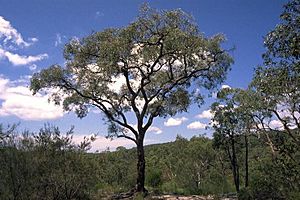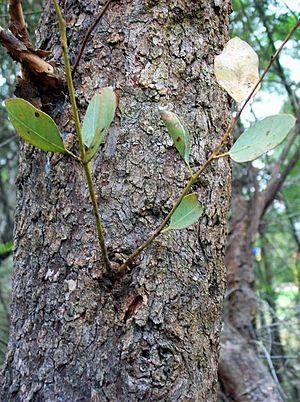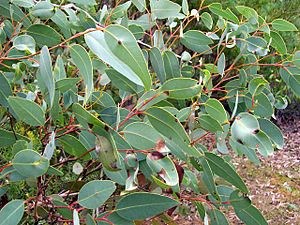Scaly bark facts for kids
Quick facts for kids Scaly bark |
|
|---|---|
 |
|
| Eucalyptus squamosa near Berowra | |
| Scientific classification | |
| Genus: |
Eucalyptus
|
| Species: |
squamosa
|

The Scaly Bark (Eucalyptus squamosa) is a special type of tree. It is a small to medium-sized tree that only grows in the Sydney area of New South Wales, Australia. This means it is endemic to that region.
It gets its name from its bark, which looks rough and flaky, like scales. The tree also has long, curved leaves, white flowers, and fruit shaped like a cup.
Contents
What Does Scaly Bark Look Like?
The Scaly Bark tree usually grows to be about 12 to 15 meters tall. It has rough bark that can be grey or reddish-brown. This bark covers its trunk and branches.
Leaves of the Scaly Bark
- Young plants have dull green, egg-shaped leaves. These leaves are about 4.5 to 10 centimeters long.
- Older leaves are a bit different. They are green to greyish and shaped like a spear or curved.
- These adult leaves are about 6 to 13 centimeters long. They grow in a way that they alternate along the stem.
Flowers and Fruit
- The flower buds grow in groups of seven, nine, or eleven. They are oval-shaped and have a pointed cap.
- Scaly Bark trees bloom from October to December. Their flowers are white.
- After flowering, the tree produces woody fruit. These fruits are shaped like a cup or half a sphere. They are about 4 to 7 millimeters long.
How Scaly Bark Got Its Name
The Scaly Bark tree was first officially described in 1898. Two scientists, Joseph Maiden and Henry Deane, gave it its scientific name, Eucalyptus squamosa.
The word squamosa comes from a Latin word. It means "scaly," which perfectly describes the tree's unique bark.
Where Scaly Bark Lives
Scaly Bark trees grow in a type of forest called sclerophyll woodland. They prefer areas where soil collects in hollows on sandstone plateaus. You can find them in the Sydney region.
Their habitat stretches between the Putty and Broke areas. They also grow in the Royal National Park.


